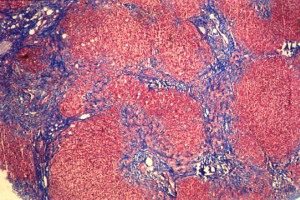
Fibrosis of the liver is a scarring process by which the liver reacts to injury. It’s similar to scarring in other parts of the by in that it involves the depositing of matrix constituents such as collagen. The injuries may be trauma exerted from outside or the effects of internal chemistry. Depending on the degree of scarring, fibrosis can result in impairment of blood flow to the liver cells, impairment of liver functioning, and further damage from the impaired blood flow leading to more scarring. Fibrosis occurs with the second and later stages of cirrhosis of the liver, but can also occur independently from other causes. It is always a reason for medical concern and involves at least some impairment of liver functioning and potentially very severe impairment.
Symptoms
Fibrosis of the liver produces symptoms in three general categories. First, it is associated with elevations of liver enzymes. In fact, elevated liver enzymes should show up in blood tests before any actual fibrosis occurs, in response to the damage that leads to the fibrosis. Second, liver fibrosis may be detected using medical imaging technology such as an ultrasound, in which the fibrous growths appear visually. Third, as liver functioning is impaired overt symptoms may manifest including inflammation, pain in the area of the liver, loss of appetite, nausea and vomiting, jaundice (yellowing of the skin and the whites of the eyes), and discoloration of the skin in rash-
Diagnosis
The first indicator of fibrosis of the liver is normally a blood test. Elevated levels of alanine transaminase (ALT) are in most cases the first indicator of liver disease of any kind. Upon finding elevated ALT, more blood tests may be performed, particularly a test for the ratio between ALT and aspartate transaminase (AST) which can help differentiate between liver diseases and to confirm the presence of liver disease. Use of medical imaging technology such as ultrasound or MRI is the next step in most cases. This can reveal a number of different liver disorders, including fibrosis but also including fatty liver disease, hepatitis, and cirrhosis of the liver. A final diagnostic procedure is to perform a biopsy, taking a sample of liver tissue for various diagnostic procedures that can reveal cirrhosis, liver cancer, and viral infections.
Risk Factors
As fibrosis is a manifestation of damage to the liver and not a discrete disease, all factors that can cause liver damage or place a person at risk for liver damage increase the chances of scarring and fibrosis of the liver. The most obvious and common risk factor is alcohol abuse. The liver plays a major part in metabolism of alcohol, so that excessive drinking very commonly causes damage to the liver. Other common causes of fibrosis include obesity, diabetes, and infectious hepatitis. Fibrosis also occurs as a result of cirrhosis of the liver, which is a much more serious illness than fibrosis in and of itself.
Cirrhosis
Cirrhosis of the liver is a progressive condition that becomes life-
Treatment
Again, fibrosis of the liver is a condition or consequence of liver damage rather than an illness in itself. Treatment of fibrosis is therefore determined by what is causing the condition. Treatment of liver disease other than cancer, infectious hepatitis, and the last stage of cirrhosis generally involves identifying the cause of the liver damage and correcting that cause, arresting the progression of the disease and in many cases allowing the damage to heal and reverse itself. The specific treatment will obviously differ with different causes of the problem. In the case of alcoholic liver disease, cessation of drinking is indicated. If the cause is obesity, gradual weight loss through diet and exercise is appropriate. If diabetes is the culprit, treatment of that disease is the right approach, and the same is true for infectious causes such as type A, B, or C viral hepatitis.
When a liver disease such as cirrhosis of the liver has progressed to its terminal phase, the only treatment that can allow for survival is a liver transplant.